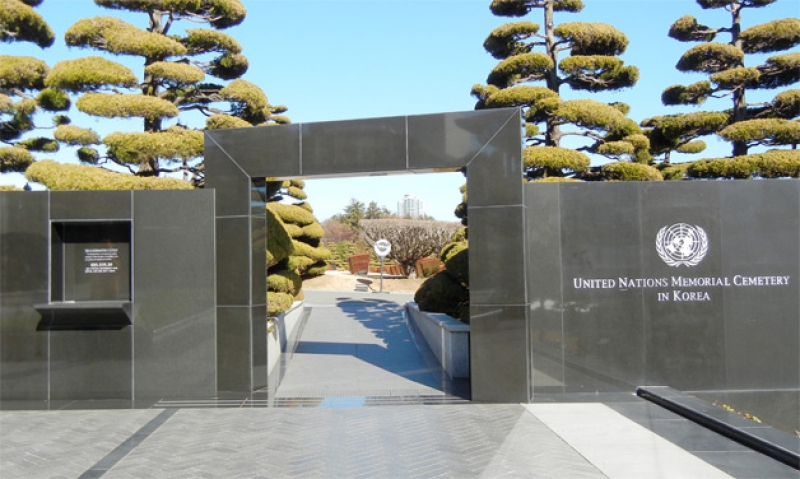
New monument in South Korea to honor U.S. troops
Nearly six decades after the Korean War armistice was signed, the United Nations Cemetery in Pusan, South Korea, is finally getting a monument that honors U.S. forces who fought there. While monuments to other U.N. forces have been erected at the cemetery, the sacrifice of American troops has yet to be recognized in such a way.
"We will begin construction on a monument this spring and plan to dedicate it in July on the 60th anniversary of the signing of the Korean War armistice," said Raymond Wollman, deputy secretary of the American Battle Monuments Commission (ABMC).
Wollman’s announcement was part of his April 10 testimony before the House Veterans’ Affairs Subcommittee on Disability Assistance and Memorial Affairs. He also testified that three visitors’ center projects will be completed this year: one at the Cambridge American Cemetery in England, another at the Sicily-Rome American Cemetery and Memorial near Anzio, Italy; and a third at the Pointe du Hoc Ranger Monument in Normandy, France.
ABMC’s first mobile app, a tour of the Pointe du Hoc battlefield, was released last December. The app gives users a virtual experience of the site, where U.S. Army Rangers scaled 100-foot cliffs during the June 1944 Normandy invasion to destroy a critical German battery and take control of the coastal highway. "We plan to produce apps and virtual tours for all of our sites," Wollman said, "so we can bring these national historic assets to life — not only to our visitors, but on our website and in our classrooms."
Congress has authorized $5 million for ABMC to restore, operate and maintain Clark Veterans Cemetery in the Philippines. Wollman said an agreement is being negotiated with the Philippine government, but the funding "may be insufficient for a cemetery that is partially covered in volcanic ash and may have other unknown infrastructure issues. We won’t know the true cost until we complete a site assessment. Nonetheless, the mission has been assigned to the ABMC, and we will work toward executing that mission when an agreement allowing us to do so has been signed with the Philippine government."
Kathryn Condon, executive director of Arlington National Cemetery (ANC), told the subcommittee that the cemetery had made much progress in its new digital environment. "Long gone are the typewriters, the three-by-five index cards and the paper maps colored in with pencils," Condon said. "In less than two years, we are the first national cemetery to geo-spatially manage cemetery operations."
As directed by Congress, Condon said that ANC has achieved baseline accountability for all of its burial records and has created a single, verifiable and authoritative data base of all those laid to rest at the cemetery. The data base is linked to a digital mapping system that "allows us now to not only assign (and) manage, but to track our grave sites electronically."
Last October, the cemetery launched its ANC Explorer mobile app that allows users to locate grave sites, monuments and memorials. Since then, Condon reported the app had been downloaded more than 40,000 times. "That allows the public to honor, remember and explore the national shrine virtually — wherever they want, whenever they want."
Kiosks with ANC Explorer have been installed at Arlington’s welcome center; more will soon be installed at locations throughout the cemetery.
ANC currently has three expansion projects: Columbarium Court 9, the Millennium Project and the Navy Annex Project. "Once completed," Condon said, "these projects should extend Arlington’s first interment burials well into the 2050s."
The new columbarium’s dedication is scheduled for May 9. Covering nearly 63,000 square feet, the $12.9 million structure will add more than 20,000 niche spaces, extending until 2024 the availability of first inurnments. The Millennium and Navy Annex projects will also add thousands of grave sites and urn niches to the cemetery.
Condon told the subcommittee that, while ANC has made great strides, "work remains to complete the critical repairs of our crumbling infrastructure, and to improve our service to our veterans by reducing the wait time between the family’s initial request and the actual burial."
Veterans access to burial benefits was increased in 2012, with $31.8 million worth of expansions and improvement projects completed at national cemeteries. Steve Muro, under secretary for memorial affairs in the Department of Veterans Affairs (VA) National Cemetery Administration (NCA), also reported to the subcommittee that land acquisition and planning for the construction of five new national cemeteries has been initiated.
Five new columbarium sites are being constructed in densely populated urban areas, and eight more national cemetery burial grounds are being added in rural areas.
Muro said NCA awarded 18 grants to states and American Indian tribes to build or improve the veterans cemeteries they manage. "Taken together, these actions will contribute to 95 percent of the veterans having a burial option within 75 miles of their home by 2015," he said. In 2004, 75 percent of America’s veterans had such an option.
NCA also launched an online resource kit last year for funeral directors, which contains pertinent information that helps families plan for burials and apply for VA benefits.
